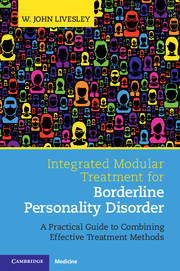 Integrated Modular Treatment for Borderline Personality Disorder
Integrated Modular Treatment for Borderline Personality Disorder Book contents
- Frontmatter
- Dedication
- Contents
- Preface
- Section 1 Introduction and Framework for Understanding Borderline Personality Disorder
- Section 2 Assessment and Treatment Planning
- Section 3 General Treatment Modules
- Introduction
- 7 General Treatment Module 1: Structure
- 8 General Treatment Module 2: Treatment Relationship
- 9 General Treatment Module 3: Consistency 101ment Module 3: Consistency
- 10 General Treatment Module 4: Validation
- 11 General Treatment Module 5: Self-Reflection
- 12 General Treatment Module 6: Motivation
- Section 4 Safety, Containment, and Engagement: The Initial Phase of Treatment
- Section 5 Improving Emotional Regulation and Modulation
- Section 6 Exploration and Change: Treating Interpersonal Problems
- Section 7 Constructing an Adaptive Sense of Self
- Section 8 Retrospect and Prospect
- References
- Index
8 - General Treatment Module 2: Treatment Relationship
from Section 3 - General Treatment Modules
Published online by Cambridge University Press: 16 February 2017
- Frontmatter
- Dedication
- Contents
- Preface
- Section 1 Introduction and Framework for Understanding Borderline Personality Disorder
- Section 2 Assessment and Treatment Planning
- Section 3 General Treatment Modules
- Introduction
- 7 General Treatment Module 1: Structure
- 8 General Treatment Module 2: Treatment Relationship
- 9 General Treatment Module 3: Consistency 101ment Module 3: Consistency
- 10 General Treatment Module 4: Validation
- 11 General Treatment Module 5: Self-Reflection
- 12 General Treatment Module 6: Motivation
- Section 4 Safety, Containment, and Engagement: The Initial Phase of Treatment
- Section 5 Improving Emotional Regulation and Modulation
- Section 6 Exploration and Change: Treating Interpersonal Problems
- Section 7 Constructing an Adaptive Sense of Self
- Section 8 Retrospect and Prospect
- References
- Index
Summary
All therapies agree that the main task in treating borderline personality disorder (BPD) is to build a good working relationship and bond with the patient because these predict outcome. This relationship is variously referred to as the therapeutic relationship, the working alliance, and the working relationship and hence these terms will be used interchangeably. The essential characteristic of the alliance is patient–therapist collaboration in working for the patient's benefit. The alliance results from the patient forming a positive bond with the therapist who is perceived as helpful, supportive, trustworthy, and reliable. A good alliance is often achieved as much by the manner in which the therapist approaches the patient as by what is done and said. A warm, supportive, open manner promotes engagement.
Given the importance of the alliance, therapists need to monitor it carefully and intervene quickly when problems arise. We usually know intuitively how treatment is going. When treatment is progressing, the patient is engaged, actively participating in the process, and is open to exploring issues and trying new things. We also intuitively recognize when things are off track. The patient seems disinterested, silent, relatively uncommunicative, angry, or tetchy. Therapists also feel a little less engaged, and even bored or irritated. Nevertheless, it is the patient's perceptions of the alliance, not the therapist's, that predicts the outcome. Hence therapists should not rely solely on their own impressions but also ask patients about how they see therapy and the relationship, and whether they think that they are helpful.
Without a good alliance, outcome is poor and dropouts are common probably because the alliance influences motivation for treatment. A good therapeutic relationship also has a settling effect: it provides the support needed to contain distress. As distress settles, it becomes possible to work more directly on problems as opposed to struggling with unstable emotions.
Professional and Social Relationships
When thinking about an effective patient–therapist relationship, it is useful to recall how therapeutic relationships differ from social relationships established with friends and acquaintances. Many staff confuse the two. Social relationships are typically reciprocal: both parties expect to give something to, and to get something from, the relationship. When this does not happen, the relationship is experienced as unsatisfying and one-sided and most people think about ending it.
- Type
- Chapter
- Information
- Integrated Modular Treatment for Borderline Personality DisorderA Practical Guide to Combining Effective Treatment Methods, pp. 88 - 100Publisher: Cambridge University PressPrint publication year: 2017


